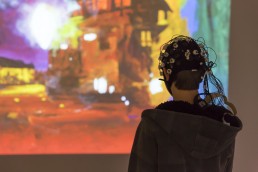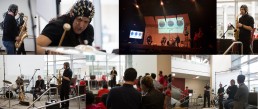Dr. Contreras-Vidal
Jose Luis Contreras-Vidal is a Hugh Roy and Lillie Cranz Cullen Distinguished Professor of Electrical and Computer Engineering at the University of Houston. Dr. Contreras-Vidal’s research focuses on neural, cognitive and rehabilitation engineering, and development of noninvasive brain-machine interface (BMI) and other human-machine systems to restore or assist movement in clinical populations with upper and lower-limb disabilities. His laboratory has pioneered the development of noninvasive neural decoding methods based on scalp EEG and closed-loop BMIs to robotic exoskeletons and prosthetic limbs to restore motor function in individuals with spinal cord injury, stroke, and limb amputation. He has also developed experimental and computational approaches to acquire brain activity in ‘action and in context’ in complex real settings.
Brain on Arts-Museum Exhibits
In this study, we partnered with our collaborators at Blaffer, Smithsonian, Synthesis Center and the Contemporary Art Museum-Monterrey to accelerate the acquisition of cognitive, affective, movement, neural and demographic data from the general public attending art exhibits, interactive displays, and programmed performance events. The objective is to characterize the stability and individuality of the qEEG measurements as a function of time of the day (AM/PM), location, type of art exhibit/object, and a number of demographic, cultural and neurological factors, as well as decode affective and cognitive states from brain activity.
[soliloquy id="380"]
Exquisite Corpse-Dancers
Wearing skullcaps equipped with sensors, UH dancer-choreographers played a variation of Exquisite Corpse, a collaborative, chance-based game made famous by the Surrealists in the 1920s — but they were dancing rather than drawing.
The event was part of a groundbreaking collaboration between Blaffer Art Museum, Houston-based artists, and the University of Houston’s Noninvasive Brain-Machine Interface Systems Laboratory, seeking clues to what happens in the brain as people create, perform, and contemplate art. For this event, we also partnered with the School of Theatre & Dance.
[soliloquy id="358"]
Minecraft
In this study, we partnered with the Children’s Museum of Houston (CMH) to investigate the brain dynamics of children playing Minecraft – a creative game that enable players to build 3D constructions using textured cubes in a virtual world. The goal was to investigate the feasibility of assaying the neural responses associated with creative game playing in a museum setting and to identify differences in brain activity as a function of age, gender, and gaming experience. Scalp electroencephalography (EEG) and head motion were acquired using off-the-shelf, low-cost, mobile brain-body imaging (MoBI) technology that limited recording to electrodes in the anterior and the temporal scalp areas.
[soliloquy id="316"]
Calm over the horizon
Many years ago, I worked for my parents who own a video production company. Because it is a family business, you inevitably end up wearing many hats and being the czar of many different jobs. I mainly managed projects and worked as a video editor. On production, there were times that I was called on to work as an audio tech and was made to wear headphones on long production days. In those days, having a really good set of headphones that picked up every nuance of sound was essential to making sure the client got what they needed.
First impressions.
Naturally, my first impression of these headphones is based off of the look of them. They have a classic over-the-ear style that is highlighted by a blue LED light that indicates the power for the noise canceling. The padding on the ear pieces seems adequate for extended usage periods.
They are wired headphones, but the 3.5mm stereo mini-plug cable is detachable. Something else I noticed right of the bat was the very nice carrying case that comes with them. It has a hard plastic exterior with a soft cloth interior that helps to protect the surface of the headphones from scratches. I never truly appreciated cases for headphones until I started carrying them from place-to-place. Now I can’t imagine not having a case.
A perfect fit.
Once I gave the headphones a thorough once-over exam, I tried them on. As I mentioned, they have a classic over-the-ear style and just looking at them, the padding on the ear pieces seem adequate and the peak of the headband seemed to be a bit lacking, but you don’t really know comfort unless you try on the product. So, I slipped the headphones on and found them to be exquisitely comfortable.
Quality.
Now that I had the headphones on my head, I was finally ready to plug and play some music. I plugged the provided cable into the jack on the headphones and then the one on my iPhone 6. Then I called up Pandora. I tend to have a very eclectic music purview and have many stations set up for different moods. From John Williams to Fallout Boy, the sound quality of these headphones was remarkable. There is an amazing depth of sound and incredible highs and lows that make listening to music a truly breathtaking experience.
It’s safe to say that because of my unique professional experiences, I’ve tested out a lot of headphones.
In order to test how voices sounded, and the overall art of sound mixing, I pulled up Netflix on my iPad Air 2 and watched a few minutes of a movie to hear all the nuances of the film. None of them were lost. In fact, I ended up hearing sounds that I hadn’t heard before. Echoes…birds chirping…wind blowing through trees…breathing of the characters…it was very impressive what the headphones ended up bringing out for me.
I would highly recommend these to any sound mixing specialist.


